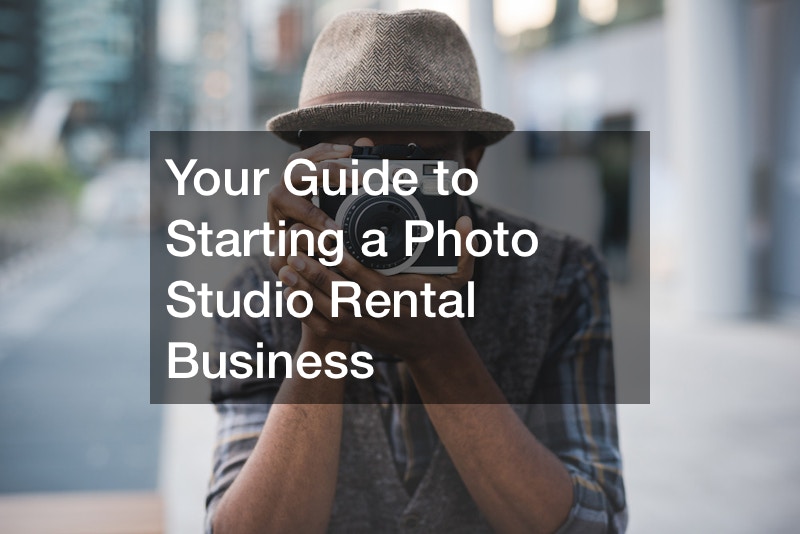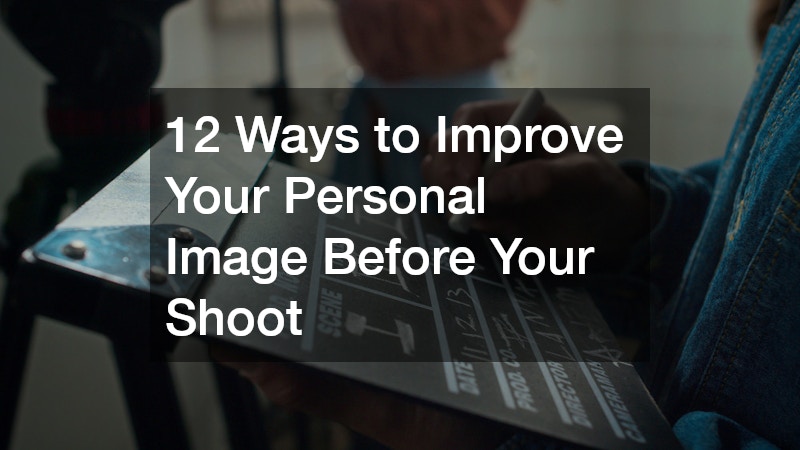
Starting and operating a rental studio business can be very rewarding if you use the right approach. You can make a lot of money, help people create memories, and have flexible hours. However, it’s not all roses. There are many challenges which may occur. This guide will give more insights on starting a photo studio rental business from nothing.
1. Prepare Your Finances

Having your finances in check is crucial in starting a photo studio rental business. You’ll need to consult an accountant to review your financial status. These professionals will assess your personal assets, liabilities, income streams, and expenses.
This will enable you to know the amount of capital you can put toward your new business venture. Based on their assessment, you may need to adjust your budget and lifestyle to free up more funds to invest in your studio. Cutting non-essential expenses, paying off debts, and boosting your savings will strengthen your financial standing pre-launch.
Your accountant can advise you on the initial start-up costs for leasing a studio space, purchasing equipment, hiring staff, marketing, insurance, etc. Know your numbers inside and out to realistically project expenses versus income. Setting aside 6-12 months of living expenses before going into entrepreneurship is wise. An emergency fund will help you stay afloat during unpredictable months as you work to build your clients.
You’ll also need ample reserves to cover costs should equipment need replacing or significant repairs arise. Taking out a small business loan through your bank may be necessary to cover all start-up and operating costs in those critical first years. Your accountant can help you weigh the pros and cons of funding your business solely through savings versus taking on business debt.
2. Purchase the Equipment You Need
Fitting a studio with high-quality gear is essential for attracting discerning photographer clients. Rent specialty equipment like fog machines as needed for specific shoots. Investing in quality furniture and decor will help you create a creative set design.
Prioritize essential camera accessories like memory cards, batteries, a reliable clamp, and rental cleaning supplies. Take time to test all equipment to market well-maintained gear personally and confidently. Purchasing the right equipment is essential for starting a photo studio rental business.
You’ll need high-quality cameras, lenses, lighting gear, backdrops, tripods, and reflectors to outfit your rental studio. Investing in durable, industry-standard equipment from reputable brands will provide clients with the tools they need to create professional images. Carefully curating the photography tools based on popularity, versatility, durability, and long-term value are wise steps for starting a well-equipped studio rental business.
3. Find a Waste Removal Solution

Operating a photo studio produces refuse like scrap paper, packaging, and food waste. Partner with local dumpster rental companies to establish efficient waste collection. Schedule pickup frequencies and bin sizes based on your typical garbage volumes.
Provide labeled recycling bins for plastics, glass, paper, and cardboard. Compost food scraps if possible. Keep the studio tidy by designating receptacles for trash and recycling in all rooms. Handle hazardous materials like used batteries and light bulbs responsibly.
One of the most crucial but overlooked logistical factors when starting a photo studio rental business is managing waste generated during shoots. Photography sessions produce substantial garbage, especially regarding discarded props, product packaging, leftover food, and other random debris. You’ll need to partner with a reliable dumpster rental company that can provide an easy waste removal solution.
Research local dumpster companies, get quotes for different-sized containers and pick up frequencies. The amount of trash hauling you’ll need depends on your studio’s size and expected usage. A small studio with occasional weekend bookings can get by with just a bare 6-yard dumpster picked up once a week.
A larger studio with multiple daily bookings will likely fill up bigger ten or 15-yard dumpsters much faster and require 2-3 weekly pickups. When comparing rates, look at all-inclusive pricing covering dumpster delivery, pickup, disposal fees, and other charges. Ask about additional costs like overage fees if you ever overfill a dumpster between cleanouts.
Once you choose a dumpster company, schedule recurring service so a dumpster is always on-site. Place it in an accessible area away from entrances but close enough for convenient use. The right local dumpster rental partner can make it easy and hassle-free.
4. Remodel Your Space
Being a photographer thinking of starting a photo studio rental business, one of the first steps is finding and remodeling a suitable space. Follow all local building codes and use proper construction scaffolding when working at height. Choose an open layout with high ceilings for versatility when setting up lights and backdrops.
Install neutral-colored walls and floors that can provide seamless backgrounds. Ensure ample electrical outlets, power supply for all the lighting equipment, and soundproofing to eliminate outside noise. Build a viewing area or separate space where clients can review photos.
Outfit your studio with versatile furniture like movable screens and backdrops. Gather an assortment of props and accessories for styled shoots. Invest in sufficient sturdy light stands, soft boxes, umbrellas, reflectors – all the essentials to sculpt flattering lighting. Stock up on expendables like gels, gaff tape, sandbags, and bounce cards. A well-designed photo studio helps attract clients looking to rent an efficient, fully-equipped space for their shoots.
5. Create a Comfortable Environment

A comfortable environment is important when starting a photo studio rental business. Invest in quality HVAC services to regulate temperature and humidity. Regulating temperature and humidity is especially important for protecting clients’ expensive photography equipment. Work with a reputable AC repair company to install and maintain climate control systems. Dehumidifying services help in reducing moisture to prevent condensation on cameras and electronics.
Supplement with portable fans and space heaters as needed. Strategically place them near common photography set-ups and adjust as required. The air circulation will keep the space fresh.
Appearance also affects ambiance. Keep the space clean and decluttered. Fresh coats of neutral-colored paint make the backdrop versatile. Style with elegant furniture and accessories for a polished look. However, limit excess decor that could distract or clutter the frame. Let the studio layout remain flexible to accommodate different types of shoots.
Outfit the studio with amenities like WiFi, charging stations, lounge areas, and a kitchenette. Offer beverages and light snacks to make clients feel at home. Include a dressing room for models to relax and prep between shots.
Proper lighting equipment also enhances comfort. Continuous studio lamps emit less heat than strobe lighting. Large fans circulate air, while blackout curtains block external light sources. Avoid glare and harsh shadows by using diffusers and reflectors.
Comfort extends beyond the physical workspace. Greet clients warmly and make small talk to put them at ease. Maintain a tidy reception area with complimentary beverages and snacks. Provide plush robes, slippers, and a makeup station in the dressing room. Supply portable fans, hydrating mist sprays, and bottled water on set.
6. Exhibit Exceptional Customer Service
Exceptional customer service is crucial for starting a photo studio rental business. Greet clients professionally and respond promptly to inquiries. Assist them in envisioning creative uses for the studio space. Offer equipment rentals and other services tailored to their needs.
Running a photo studio takes more than creating a comfort zone. To ensure a smooth shoot, test and prep gear ahead of time. Fully charge lighting batteries and bring extras as backup. Set up a sufficient number of power outlets.
Clean lenses and equip cameras with extra charged batteries and empty memory cards. Maintain an organized props area for easy access. Running a photo studio takes planning and care. When clients feel at ease, they can focus on producing great images.
7. Make Your Studio Accessible to Clients

When securing a space, focus on making it accessible for people with disabilities. Work with an elevator maintenance company to install an elevator if your studio will be located above the first floor of a building. Make sure doorways and halls are wide enough to accommodate wheelchairs.
Have at least one handicap-accessible restroom available for clients. Display art and decor representing different cultures, races, genders, and sexual orientations. Avoid tokenization, but make sure your studio space reflects an ethos of inclusivity. You want all clients to feel comfortable in your space.
Be ready to adjust lighting, seating arrangements, and your posture or position to accommodate individual clients. Making people feel seen and served on their terms goes a long way. Adaptability and compassion for each client’s unique needs make for an accessible photo studio.
Taking time upfront to ensure you’re starting a photo studio rental business that’s accessible to all sets you up for business success. When clients can easily access and feel comfortable inside your studio, you’re much more likely to earn their repeat business and positive word-of-mouth.
8. Replace Your Windows And Doors
Replacing the windows and doors in your rental space can significantly affect the look and feel. Most older commercial buildings have standard windows, which don’t do much in esthetics. Setting more stylish options will give your studio epic character and make it beautiful.
Choose windows and doors with materials aligned with your desired theme from local bulk windows and door shops. For instance, industrial loft-style spaces often have large steel casement windows. Boutique studios may opt for framed glass doors and windows with minimal muntins.
Windows that allow ample natural light are ideal for photography. Consider extra-large picture windows, skylights, or clerestory windows extending to the ceiling. Regarding vendors, see if local companies specialize in commercial windows and doors for retail and studio spaces. Window and door replacement can get pricey, so get several quotes to compare.
The installation will create dust and debris, so coordinate timing with your landlord and tenants neighboring the studio. Be prepared to cover or remove any sensitive photography equipment ahead of time. To limit disruptions, have the contractor complete all work quickly once started.
Schedule a professional cleaning immediately after installation. With stylish new windows and doors, your photo studio will look clean, modern, and tailor-made for creative work. Splurging on this focal part of the space is an intelligent investment that takes the aesthetics to the next level.
9. Keep Your Space Clean
Keeping your photo studio space spick and span should be a top priority. Cleanliness directly impacts the quality of shots captured. Start by decluttering the space and removing unnecessary props, backdrops, or equipment hogging up the room. Designate areas for storing each supply type, from lighting kits to reflectors and beyond.
On cleaning days, begin by dusting all surfaces. Wipe down counters, tables, and shelves first before moving onto equipment. Carefully clean camera lenses and other delicate gear using appropriate specialized clothes and solutions.
Sweep and mop floors. For any stains in backdrop fabrics or floors, have a professional do a deep clean periodically. Their powerful suctioning equipment can pulverize even the most stubborn marks.
Also, consider implementing cleaning checklists for clients to review before and after their shoots. This encourages them to leave the space as pristine as when they arrived. Place trash cans and recycling bins in accessible spots, so people can quickly dispose of any rubbish.
Keep extra cleaning supplies like disinfectant wipes for spot treatments between shoots. The time invested in maintaining order pays off where it matters – in the quality of images able to be captured. Don’t forget about the plumbing system. Enlist the help of local plumbers and commercial drain cleaning companies.
10. Maintain Your Parking Lot
Starting a photo studio rental business with a well-maintained parking lot is crucial. After all, this will likely be the first impression clients have of your space. Invest time and money into a proper parking lot upkeep routine.
Firstly, ensure the pavement is in good condition without significant cracks or potholes. Poorly maintained asphalt paving leads to slower traffic flow and safety hazards. Schedule professional repairs immediately if large sections crumble.
Parking lines and directional arrows should be bright and visible. Repaint faded lines and signs every year or two. In addition, keep landscaping around the perimeter neat.
Trees, bushes, and shrubs should be regularly trimmed back from signs or lighting. Mow grass weekly during peak growing seasons. Weed flower beds and mulch around plants to prevent overgrowth. Institute a daily walk-through to pick up stray trash or debris.
Provide plenty of garbage cans for customers to dispose of waste quickly. Pressure wash exterior walls seasonally to remove grime buildup. Be sure to budget accordingly for routine upkeep, repairs, and improvements over the years. A photogenic, accessible parking area helps attract business and smooths navigating rental sessions.
Starting a photo studio rental business can be one of the best decisions ever. It all depends on the approach you use. Use this guide to you.


